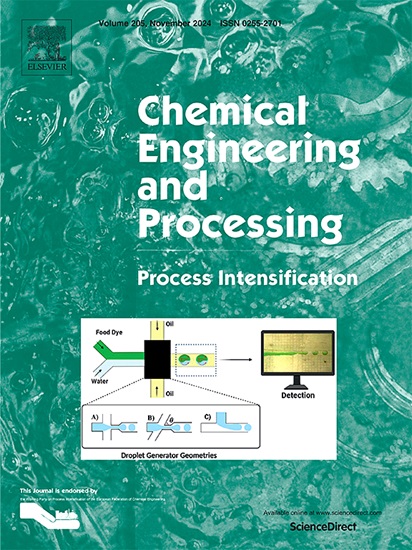Modeling and simulation of continuous fixed adsorptive distillation with adsorbent regeneration using thermal desorption
IF 3.8
3区 工程技术
Q3 ENERGY & FUELS
Chemical Engineering and Processing - Process Intensification
Pub Date : 2025-02-01
DOI:10.1016/j.cep.2024.110090
引用次数: 0
Abstract
Fixed adsorptive distillation (FAD), a hybrid separation method combining distillation and adsorption, was proven to be able to break the azeotropic point and to enhance the product purity of azeotropic solution. FAD consists of two conventional distillation columns, equipped with an inter-bed of adsorbent. To operate a continuous FAD, a pair of adsorbent beds must be utilized in which adsorption operation and adsorbent regeneration are carried out alternately. This work is a parametric study which aims to model and to simulate a continuous FAD with adsorbent regeneration using thermal desorption. The azeotropic solution model used is water-isopropyl alcohol (IPA) with adsorbent of silica. Variable analysis is conducted to derive the equations, to obtain the appropriate design variable/s, and to systematically calculate the state variables. The appropriate design variables are the adsorptive flow (Adf) and the bottom product of Column 2 (B2); while the recycle variable is the distillate of Column 2 (D2). The successful continuous FAD is measured based on the composition of IPA in the feed of Column 2 (xF2) and that in the distillate of Column 2 (xD2); both must be above the azeotropic point. To ensure the successful continuous FAD with a fresh feed of 100 mol/min. (30 % mole IPA), relatively pure water and IPA in both bottoms, and equal flow split of adsorptive-bypass flow (Rf = 1), the adsorptive flow and the flow rate of bottom product of Column 2 are operated at (25.00–107.00) mol/min. and (29.77–30.29) mol/min., respectively.

求助全文
约1分钟内获得全文
求助全文
来源期刊
CiteScore
7.80
自引率
9.30%
发文量
408
审稿时长
49 days
期刊介绍:
Chemical Engineering and Processing: Process Intensification is intended for practicing researchers in industry and academia, working in the field of Process Engineering and related to the subject of Process Intensification.Articles published in the Journal demonstrate how novel discoveries, developments and theories in the field of Process Engineering and in particular Process Intensification may be used for analysis and design of innovative equipment and processing methods with substantially improved sustainability, efficiency and environmental performance.

 求助内容:
求助内容: 应助结果提醒方式:
应助结果提醒方式:


